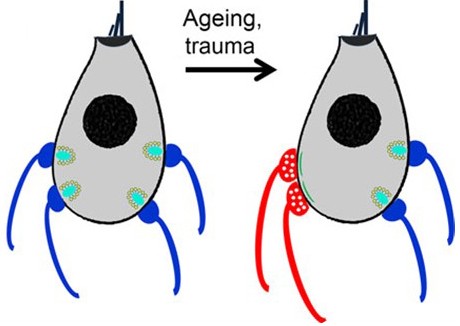Found: A Likely New Contributor to Age-Related Hearing Loss

Paul Fuchs, Johns Hopkins Medicine Mature hair cells, left, lose connections to outgoing neurons (blue) and gain connections to incoming neurons (red) as they age, right.
Conventional wisdom has long blamed age-related hearing loss almost entirely on the death of sensory hair cells in the inner ear, but research from neuroscientists at Johns Hopkins has provided new information about the workings of nerve cells that suggests otherwise.
In a paper published July 1 in The Journal of Neuroscience, the Johns Hopkins team says its studies in mice have verified an increased number of connections between certain sensory cells and nerve cells in the inner ear of aging mice. Because these connections normally tamp down hearing when an animal is exposed to loud sound, the scientists think these new connections could also be contributing to age-related hearing loss in the mice, and possibly in humans.
“The nerve cells that connect to the sensory cells of the inner ear are known to inhibit hearing, and although it’s not yet clear whether that’s their function in older mice, it’s quite likely,” says Paul Fuchs, Ph.D., the John E. Bordley Professor of Otolaryngology–Head and Neck Surgery at the Johns Hopkins University School of Medicine. “If confirmed, our findings give us new ideas for how physicians may someday treat or prevent age-related hearing loss.”
Fuchs says the new research builds on the knowledge that inside the ear lies a coiled row of sensory cells responsible for converting sound waves into electrical signals sent through nerve cells to the brain, which processes and tells animals what they “hear.” Two sets of these so-called hair cells — named for the filaments that act like antennae picking up sound waves — exist, an inner tier closest to the brain and an outer tier. The outer ones have a secondary function: to amplify the sound waves within the inner ear. Not surprisingly, Fuchs notes, a loss of outer hair cells closely correlates with a loss of hearing.
But studies over the last decade have suggested that changes over time also occur in the connections between hair cells and the nerve cells to which they are attached.
Each of those nerve cells is like a one-way street, Fuchs says, taking signals either from the ear to the brain or vice versa. The nerve cells that take signals to the ear are known to turn down the amplification provided by outer hair cells when an animal is, for example, exposed to a noisy environment for an extended period of time.
Previous research has suggested that with age, inner hair cells in mice and humans experience a decrease in outgoing nerve cell connections, while incoming nerve cell connections increase.
To find out if the new connections worked — or worked normally — Stephen Zachary, a graduate student in Fuchs’ laboratory, painstakingly recorded electrical signals from within the inner hair cells of young and old mice.
He found that the incoming nerve cells were indeed active and that their activity levels correlated with the animals’ hearing abilities: The harder of hearing an animal was, the higher the activity of its incoming nerve cells.
“These nerve cell connections seem to be reverting back to the way they worked during early development before the animals’ sense of hearing was operating,” says Fuchs. “We don’t know why the new connections form, but it might be as simple as a lack of competition for space once the outgoing nerve cells have retracted.”
If the same phenomenon is occurring in human ears, Fuchs and his team say there may be ways of preventing the incoming nerve cells from forming new connections with inner hair cells, a technique that could help maintain normal hearing through old age.
This work was supported by grants from the National Institute on Deafness and Other Communication Disorders (R01 DC001508, T32 DC000023, P30 DC005211, F31 DC014184).
Contact Information
Catherine Kolf
Senior Communications Specialist
ckolf@jhmi.edu
Phone: 443-287-2251
Mobile: 443-440-1929
Media Contact
More Information:
http://www.jhmi.eduAll latest news from the category: Life Sciences and Chemistry
Articles and reports from the Life Sciences and chemistry area deal with applied and basic research into modern biology, chemistry and human medicine.
Valuable information can be found on a range of life sciences fields including bacteriology, biochemistry, bionics, bioinformatics, biophysics, biotechnology, genetics, geobotany, human biology, marine biology, microbiology, molecular biology, cellular biology, zoology, bioinorganic chemistry, microchemistry and environmental chemistry.
Newest articles

First-of-its-kind study uses remote sensing to monitor plastic debris in rivers and lakes
Remote sensing creates a cost-effective solution to monitoring plastic pollution. A first-of-its-kind study from researchers at the University of Minnesota Twin Cities shows how remote sensing can help monitor and…

Laser-based artificial neuron mimics nerve cell functions at lightning speed
With a processing speed a billion times faster than nature, chip-based laser neuron could help advance AI tasks such as pattern recognition and sequence prediction. Researchers have developed a laser-based…

Optimising the processing of plastic waste
Just one look in the yellow bin reveals a colourful jumble of different types of plastic. However, the purer and more uniform plastic waste is, the easier it is to…



